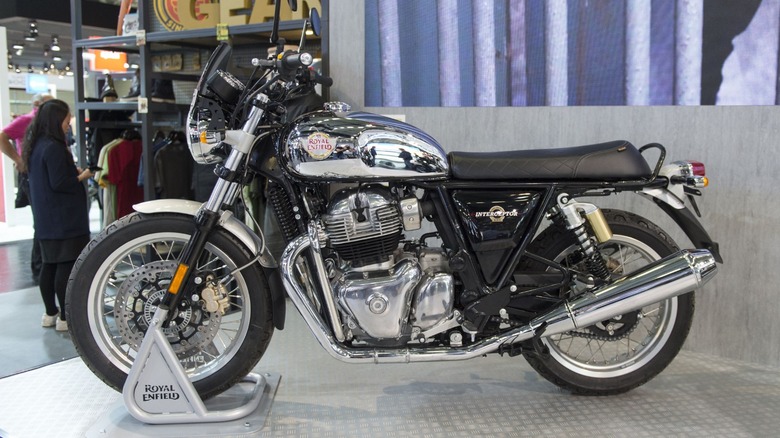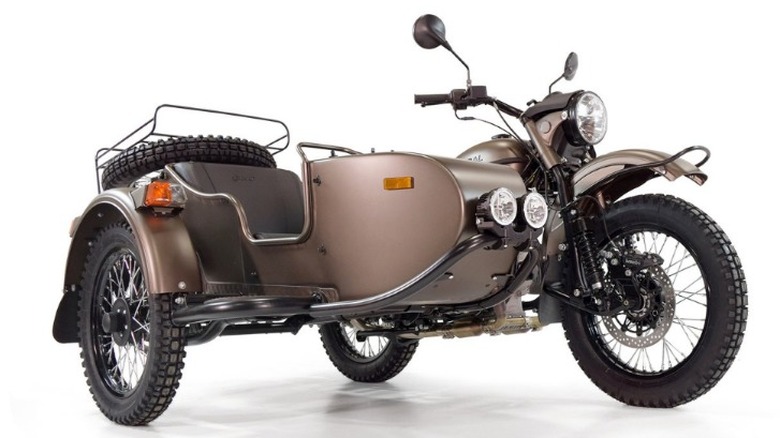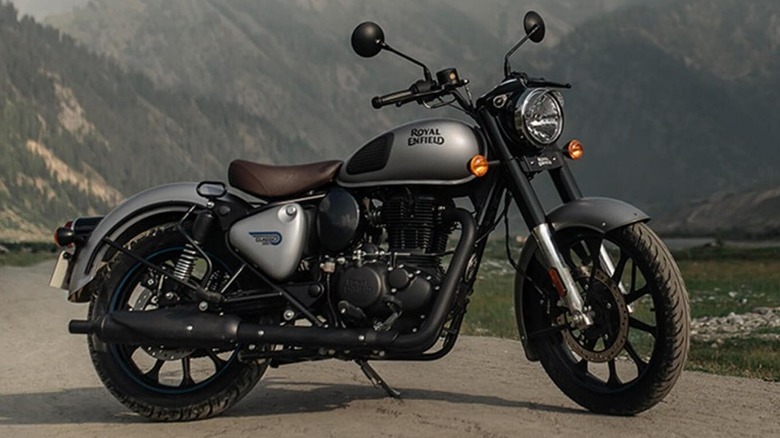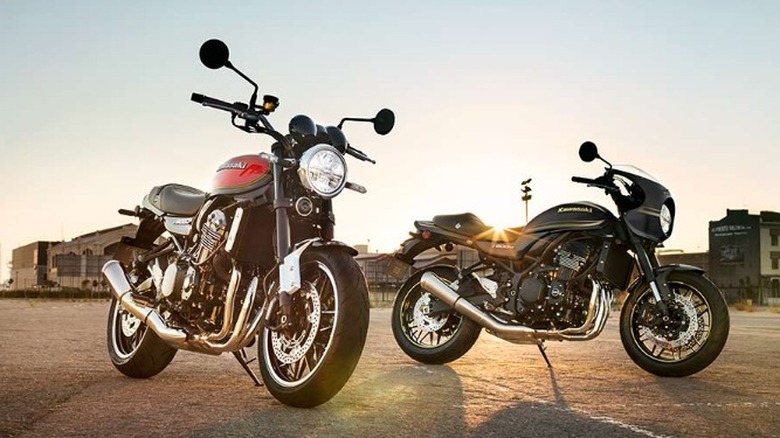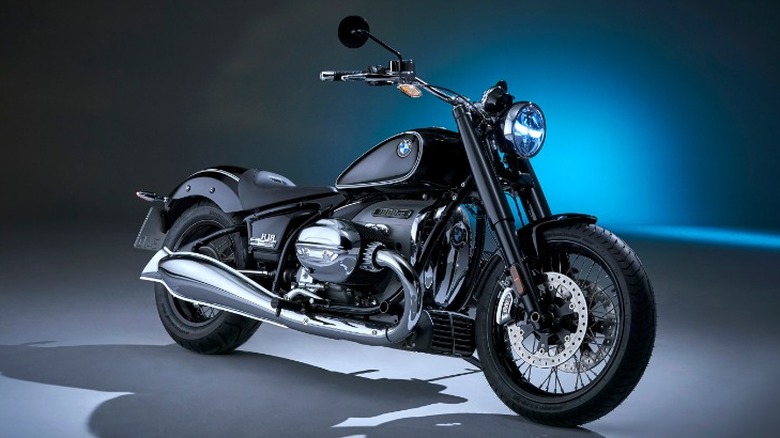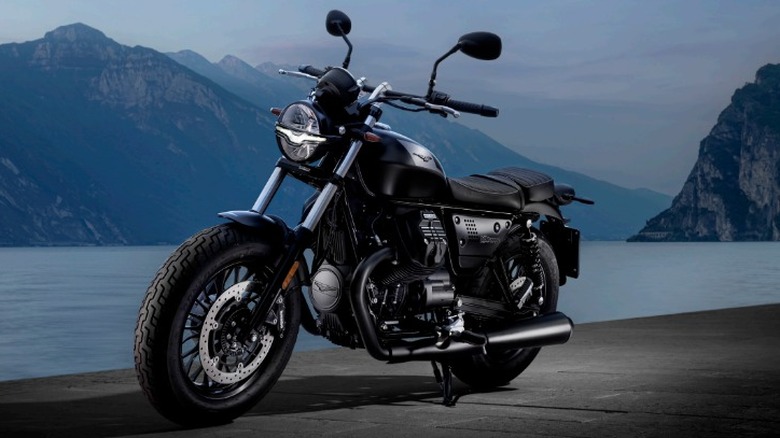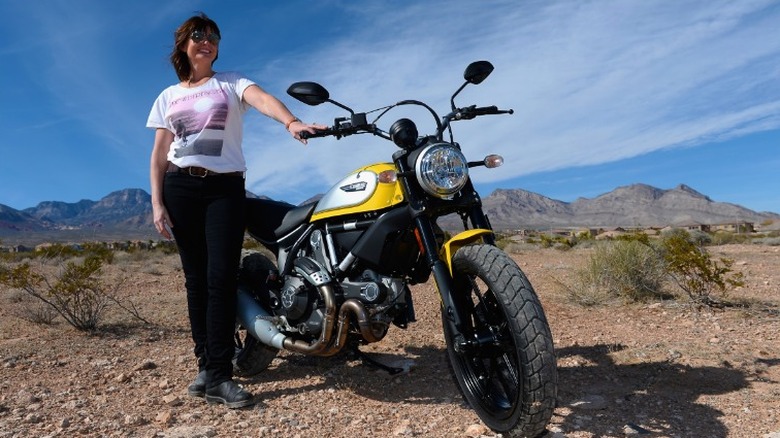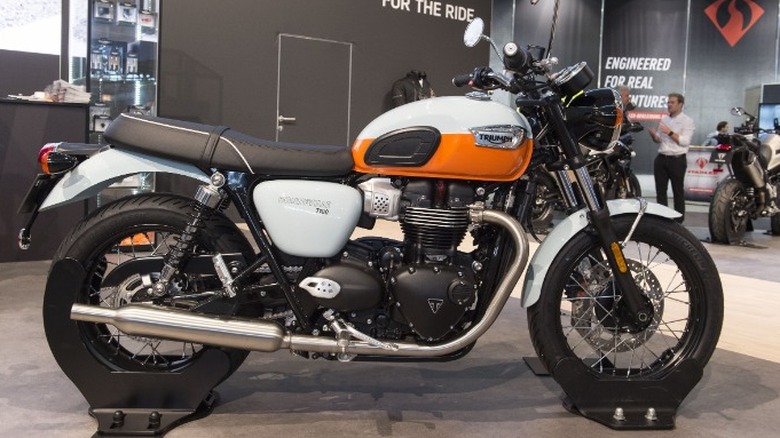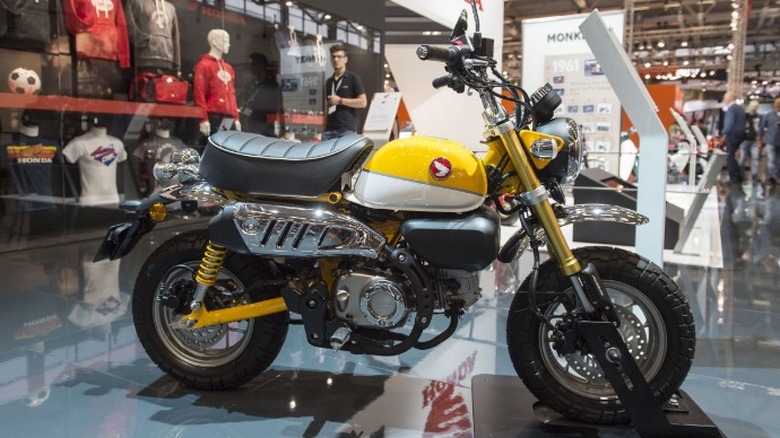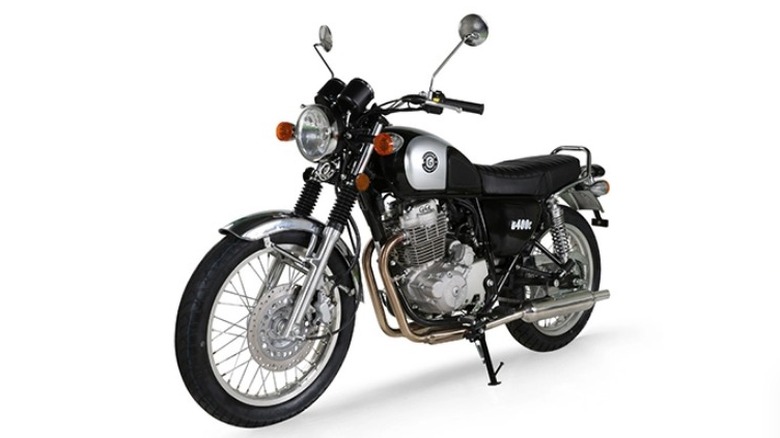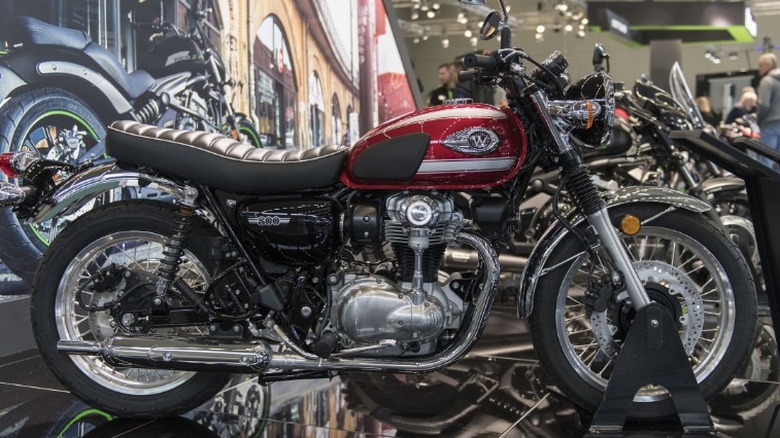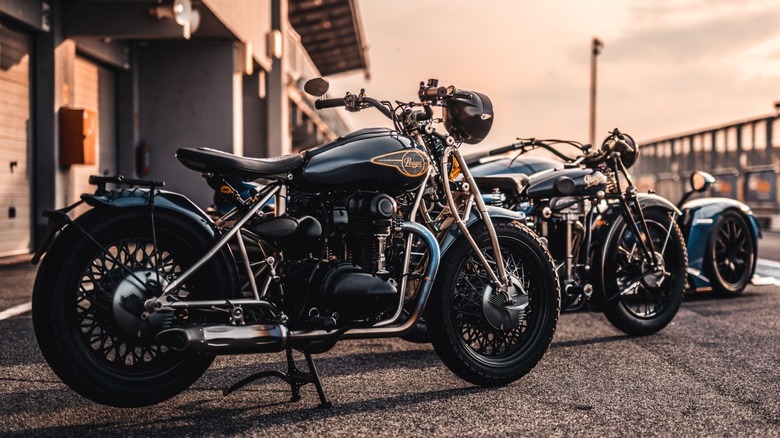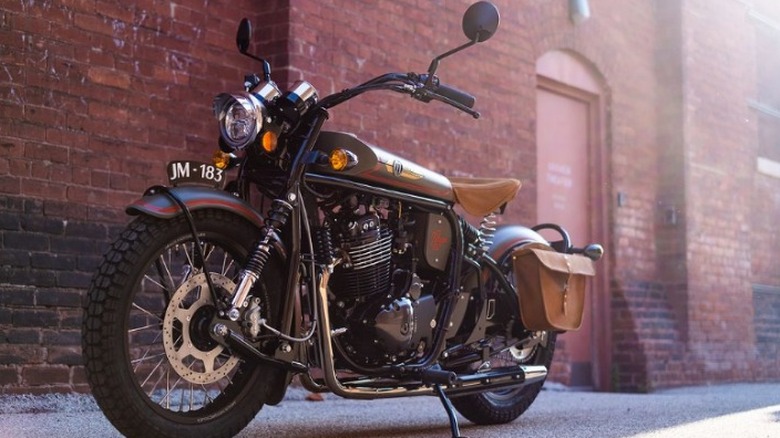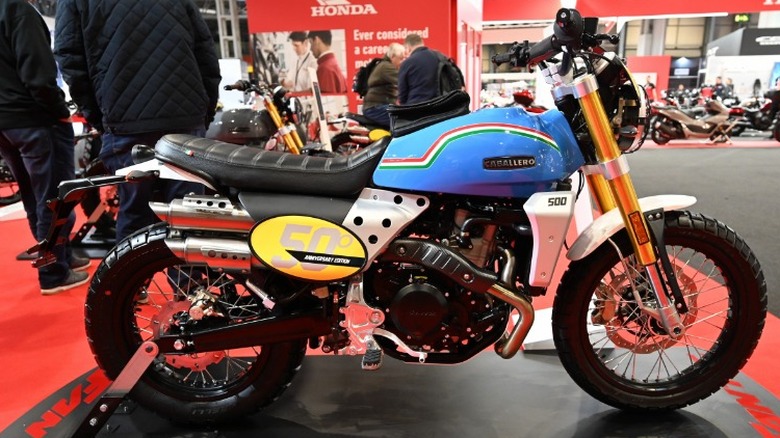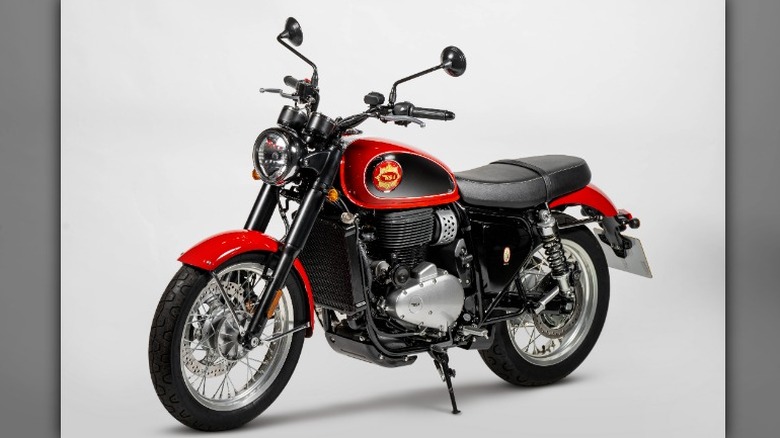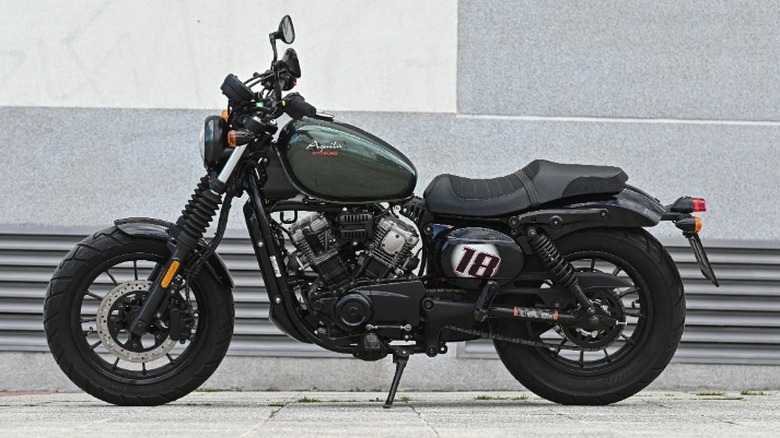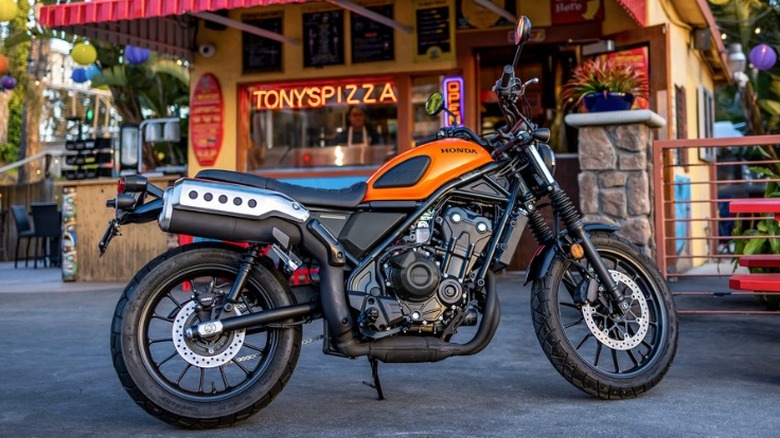The 16 Best Retro-Style Motorcycles On The Market Right Now
Motorcycle design is something that naturally lends itself to a wide variety of outcomes relating to style. This allows designers to work on the machines as mechanical canvases that offer broad interpretations of design aesthetics, leaving us with creations that differ wildly, from a Japanese scooter to an American bagger. This is a great thing for consumers as manufacturers can produce bikes to fit the personal identities of riders with vastly different objectives for what they want out of a motorcycle.
Additionally, designs have changed much over the years, with some vintage and antique designs remaining classic and beautiful expressions of their time. The oldest of these manufacturers are Harley-Davidson in the U.S. and Matchless in the U.K. Many riders appreciate the aesthetics and style of previous eras, but do not relish the idea of actually owning an antique motorcycle as it can accompany a certain level of technical skill and additional maintenance. Therefore, many companies are today making motorcycles that recycle designs of yesterday, while others have never stopped making those old machines. This means today's rider can experience something with the style of yesterday while enjoying the benefits of modern technology and reliable mechanicals. This has resulted in plenty of great vintage-inspired models on the market to choose from. Barring bikes from Harley-Davidson and Indian, since making retro bikes has mostly been their entire business model for years, here are 16 of the best retro motorcycles you can buy right now.
Ural Gear Up
IMZ-Ural has its roots at the beginning of World War II when the Soviet Ministry of Defense decided to build motorcycles for the war effort by copying the BMW R71. Fears of being exposed to German bombers prompted the moving of the factory east to the Ural mountains, where it remained until recently. With the severe sanctions imposed as a result of Russia's invasion of Ukraine, Cycle World reported that the now independent company decided to move production to Kazakhstan to continue to produce and sell motorcycles abroad. It is important to note that the motorcycle company is made up of regular citizens with no direct link to political leadership; they just want to keep making great bikes.
The primary Ural model, the Gear Up, continues to be built upon the same BMW design of the pre-war era, although it has had dozens of upgrades over the years, including components like fuel injection and Brembo disc brakes. Ural's focus is building bikes made for use with sidecars using a unique drive setup that connects the sidecar wheel to the final drive, making it two-wheel drive. This setup makes for a machine that can go anywhere, including traversing trenches and barbed wire as they were originally designed. Riding with a sidecar is a completely different experience and takes some getting used to, however, once you get a feel for it, there is nowhere you can't go. Keeping in mind this is not a highway cruiser and it does not like hitting high speed, a Ural is a blast and a perfect partner for serious adventure riding well off the beaten path.
Royal Enfield Classic 350
The Royal Enfield story begins pre-World War I in England, eventually being a supplier for the British military through two world wars. The rugged motorcycles would also prove to be popular in the British colony of India, and that led to assembly and then full-scale production in India after independence. The English company closed shop in the late '60s, but the Indians continued with the brand and it still exists to this day.
The company has since produced many different models of motorcycles, including the Bullet from 1931 to 2020. The Enfield Classic line began in 2008 and was updated for the 2022 model year. It is currently the most classically styled motorcycle from the company and it retains not just the style, but many mechanicals of historic models. In a Cycle World review, the bike shows many flaws in a modern context, with throttle response and braking capability being subpar. However, the Classic is a robust, simple, and affordable bike that is perfect for its home market but is also a good choice for budget-conscious and beginning riders in Western markets.
Kawasaki Z900RS Cafe
One of the pioneers making great performance inroads in the '70s motorcycle market was Kawasaki. Throughout the decade, the company introduced motorcycles with ever-increasing engine sizes that made more power than ever but also provided excellent reliability. In 1972, Kawasaki released its Z1 900, entering the burgeoning superbike market, featuring bigger and more powerful bikes than had been previously seen. Silodrome describes the original Z1 as a possible "King of Motorcycles" due to the incredible power and handling it offered for the time.
It appears that management at Kawasaki looked to its back catalog to resurrect one of its hits and is currently selling the Z900RS Café, a modern iteration of the original Z1 900 in the café racer style. This bike shares classic lines from the original, but the frame, engine, suspension, and pretty much everything else are updated to be competitive in today's market, and it is impressive. This bike is a powerful and capable machine, but includes many of Kawasaki's digital aids, such as traction control and ABS, to keep it manageable for less-experienced riders while maintaining the performance that veterans want. For anyone wanting a classically styled bike with tons of power and good reliability, the Z900RS Cafe is an excellent choice.
BMW R 18
If Arthur Davidson and William Harley had been born in Munich instead of Milwaukee, their company could have built the BMW R 18. In reality, this is BMW's second attempt to garner a larger portion of the huge cruiser market dominated by Harley-Davidson. Its first attempt was the R1200C, which was a complete failure. However, with this go around, it appears BMW has learned from its mistakes, as the R 18 is a beautiful machine backed up by mechanical prowess.
Built around a giant 1,800cc boxer V-twin, the R 18 does double styling duty in representing the BMW R5 of the 1930s while going up against a Harley Fat Boy in terms of style. BMW has executed this one quite well. Its hidden rear suspension gives it the look of an old hardtail and combined with its low and wide seat along with wide, swept-back handlebars make it a genuine contender for buyers of cruisers. While the bike is full of modern technology, Rider Magazine also says it has been kept to a minimum, keeping a clean and uncomplicated machine. Despite its fantastic style, it does come up a bit short by having a harsher ride than it should and excessive vibration. Regardless, in its attempt to build a good-looking cruiser to compete with the Americans, BMW has succeeded.
Moto Guzzi V9
Moto Guzzi has a knack for making motorcycles that look as if they have always existed, yet were just made. The Italian company has been building two-wheelers for a century and has created some magnificent machines in that time. Unlike many motorcycle manufacturers that start off with small displacement engines before graduating to larger ones, Moto Guzzi's first bike was 500cc, and building larger bikes for cruising the Autostrada has been its mainstay. It was in the early '60s that the company developed its V-twin engine with shaft drive.
The V-twin has become the signature of Moto Guzzi motorcycles, which is easy to recognize from each cylinder poking up from underneath the gas tank and it is the engine on its current V9 model. It comes as the Roamer or Bobber, with the latter having fat tires, shorter forks, and lower handlebars less swept back than the other model. Both share Moto Guzzi's 850cc, 90-degree V-twin with six speeds and shaft drive. Cycle World claims the bikes to be user-friendly and manageable for almost any rider. These are not speed machines, but cruisers in the classic European style.
Ducati Scrambler
Ducati is a company known for its innovation and technical expertise as a leading Italian motorcycle manufacturer that has been winning races for decades. While style is always a consideration in creating a new model, power and efficiency are primary concerns. Ducati bikes keep the flash and frills to a minimum while delivering clean and sharp bikes that go in the direction you point them as quickly as possible. Recently, the company has released a model that fits in line with this general direction but seems to use a retro class of motorcycle to guide its style. The end result is a thoroughly modern machine with inspiration from bikes of the past, the Ducati Scrambler.
Scramblers are street bikes that have been stripped down and fitted with knobby tires for use off-road. They have grown in popularity recently but have roots in the 1960s. The new Ducati model fits in line with this but has been designed from the ground up as a dual-purpose bike with the handling characteristic of a road-going street bike. The current Scrambler comes with Ducati's signature L-twin making 73 horsepower and plenty of exposed frame tubing and mechanical bits. The suspension rides a bit higher than average street bikes and the tires are typical of enduro or dual-purpose models. The current Ducati Scrambler is clearly a modern motorcycle, but with roots in the past. Regardless of how and when its styling originated, it is a great-looking bike that is sure to be a blast to ride on dirt and pavement.
Triumph Bonneville
The Bonneville name has been a mainstay for the Triumph brand since the company first built it in 1959. Over the years, the technology has changed and improved but the classic looks remain. Triumph offers the Bonneville with a 900cc parallel twin on the T100 model, with the displacement increasing to 1,200cc on the T120 model, nearly doubling the debut model's size of 650cc more than half a century ago. Other modern mechanical amenities include water cooling, electronic ignition, and fuel injection. The vintage looks belie the modern technology packed within the frame.
The reason one rides a Bonneville is not to challenge every other bike from light to light but to cruise comfortably on a bike without fuss. It has no elaborate digital screen with Bluetooth integration and GPS onboard, but the engine does offer ride-by-wire throttle control with switchable traction control and ABS. USB charging is available under the seat, which is a good place to put the electronics, as the Bonneville is all about the ride. The parallel-twin offers a generous 75 pound-feet of torque to pull confidently ahead of traffic in most conditions, and, while it can top 100 mph, the Bonneville isn't built for this kind of riding. Anyone looking for a retro-styled bike would be hard-pressed to do better than a Bonneville, the epitome of a retro motorcycle offering a modern riding experience in an archaic package.
Honda Monkey
We have seen the Honda Monkey before, back when pant legs were flared and hair was long. It is more of a toy than a motorcycle, but if a bike can't be fun like a toy, what good is it? The Monkey began as a side attraction at a Tokyo amusement park owned by Honda in the early '60s. A tiny child-sized motorbike built by Honda with its near-indestructible 49cc engine was introduced and its popularity spurred the company into making so many it entered regular production for sale to the public. Many changes were made to it before 1968 when it arrived stateside as the Mini Trail and later the Monkey due to the adult's silly look while riding them. At first, it was off-road use only but soon received the required lighting for street legal use.
The new Monkey from Honda takes the popularity of retro motorcycles to an extreme conclusion by releasing this new bike in a form nearly identical to the one made around 1978. The engine of the Monkey has grown to 125cc, largely in part to having one readily available from the wildly successful GROM. Updates from the original, besides engine size, include a digital LCD speedometer and display, fuel injection, and ABS disc brakes. The Monkey is more of a neighborhood cruiser meant for downtowns or the narrow streets in a place like Amsterdam or Tokyo, however, anyone who gets on one knows the biggest benefit of owning a Monkey is fun.
Genuine G400C
Genuine Scooter Company got its start in 2002 by contracting with a manufacturer in India to produce Vespa clones customized to its specifications and badged Stella for sale in the U.S. It later contracted with Taiwanese manufacturers to do the same thing with modern twist-and-go style models. This business model has led to steady growth over the past two decades to the point that Genuine outsold Vespa itself. Genuine later chose to offer an entry-level motorcycle to the mix, resulting in its G400C model currently on sale.
Using the same successful formula as the scooters, Genuine contracted with Shineray of China for its first motorcycle. Shineray had once provided parts to Honda for its CB400SS and continued production of the engine once that model ended production. This engine is the powerplant for the G400C, and with Genuine's high level of quality control involved in manufacturing, the end result is a good bike.
Genuine sells the G400C as an alternative to scooter riders wanting to upgrade to something a bit bigger. While the engine is now fuel injected, power is still just 26 horsepower, which is adequate and perfect for cruising around town and even on state highways. It is also a great-looking bike with styling that looks nearly identical to anything Honda released in the late '70s. The G400C is also relatively affordable at just over $4,000 and would be the perfect fit for beginning riders on a budget.
Kawasaki W800
While classic Japanese bikes of the '70s are highly fashionable at the moment, and Kawasaki has brought its Z900 back to the future, another model from the brand goes even deeper into the archives. Kawasaki was an aircraft manufacturer when it bought struggling Meguro motorcycles in the early '60s, and the first bike to come from the merger was the 1966 W1. The W1 is a large and powerful bike based on the British BSA and featured a large for Japan 500cc parallel twin. Kawasaki put its aircraft engineering expertise to work to improve it and ended up with a successful launch for the company's new venture.
Kawasaki has since revisited its first model with the current W800 which, at first glance, appears to be indistinguishable from the old W1. One could say this is retro done absolutely right. The W800 is powered by a parallel twin like the original but completely updated with an overhead camshaft, fuel injection, and modern manufacturing practices. It further has ABS disc brakes, a slip and assist clutch, and a contoured and ribbed seat. The W800 is a perfect bike for casual rides and weekend cruises with plenty of power to get on the highway while remaining small enough to easily zip through traffic. It is also unencumbered with technology, displaying nothing but two needles on the gauges and a few warning lights, just like the old days. It is a classic and retro bike in every sense and anyone riding one likely cannot help but feel cool, regardless of how true that may be.
Praga ZS 800
The country of Czechia, also known as the Czech Republic and once part of Czechoslovakia, has a long automotive history that includes many industrial breakthroughs that helped shape the modern world, beginning in the 19th century. Several industrial giants hail from this country, including Praga, a maker of cars, trucks, and motorcycles for more than a century.
Although Praga folded in the years following the end of communism, today, the company is building a limited edition reproduction of one of its most successful motorcycles, the 1928 Praga BD 500. The new bike is a faithful recreation of the original built to modern standards and is powered by Kawasaki with the same engine in the classically styled W800. This gives the Praga ZS 800 a fuel-injected 773cc parallel twin good for 65 horsepower, which should be plenty for highway cruising. Interestingly, to keep the styling consistent with the past model, drum brakes were chosen, but they will be installed on forged carbon wheels with carbon-tensioned spokes. Adjustable Öhlins suspension with a titanium spring is hidden in the front forks, and Öhlins TTX air suspension is provided for the seat as the frame is solid. Lightweight materials — nuts and bolts are titanium and carbon fiber is used where possible — and a 50:50 weight distribution should make handling excellent.
Ultimately, the Praga ZS 800 is an ultra-premium bespoke motoring product. Only 28 units will be made, all of them hand-crafted. However, for the opportunity to experience such an exclusive ride, you will need $92,226 or to be good friends with one of the 28 people passionate enough about classic Czech motorcycles to buy one.
Janus Halcyon 450
While many retro motorcycles pay tribute to the bikes of the '50s or '70s, Janus takes it back to the beginning. These American-made, hand-built motorcycles resemble machines that came out of the first workshops of Indian or Harley-Davidson before and after WWI. They have a unique appeal and cater to a select rider who values quality craftsmanship and the experience of the ride more than having the biggest and baddest ride on the road. Most Janus models are powered by engines of less than 500cc with top speeds under 60 mph, but they are beautiful machines.
The biggest Janus is the Halcyon 450. Its engine is a 445cc air-cooled single that produces just 30 horsepower. Power goes through a five-speed gearbox, and unlike the bikes of the early 20th century, the Halcyon has disc brakes on both wheels, offering excellent stopping power. The rest of the bike is very much a no-frills affair, with a simple speedometer on the handlebars with a few old-fashioned warning lights on the dial. But the Halcyon is all about style, and its open frame with sprung saddle and deep, curbed fenders all combine to produce a distinctive and classic look. Each Janus is built to order by hand in Indiana, although the engines are imported from China. Sadly, domestic suppliers for small engines are not available.
Although these bikes use small engines from China, that does not mean they are cheap. The range-topping Halcyon's base price is $14,995. The Janus website lists a few models ready to ship, but many, if not most, are built on demand with several custom options available.
Fantic Scrambler 700
Fantic is an Italian motorcycle manufacturer with roots in the late '60s. Its initial products mostly included small-bore motorcycles with engine sizes of 50 and 125cc that were heavily involved in racing motocross and trials competitions. Production ended in the '90s, and Fantic went mostly dormant until the brand was revived in 2014.
Today, Fantic offers a limited range of bikes with classic Italian flair. Its historic Caballero name is now affixed to a modern scrambler-style motorcycle powered by a Yamaha 700 twin making 74 horsepower. This modern Caballero is liquid-cooled and fuel-injected with ABS brakes and inverted forks in line with modern motorcycle standards. It is also an attractive machine that is clearly a throwback to the designs of the '70s in all the right ways.
Production for Fantic is currently handled by Zongshen in China. However, the company has recently purchased Minarelli Motori from Yamaha, gaining decades of engine-building technology and experience along with a factory in Bologna. However, new Fantic models are not simply Chinese bikes with a few Italian badges. They are of original designs with engineering done by Fantic in Italy, and production of Fantic cycles should resume in Italy soon, meaning Fantic's best days are probably still to come.
BSA Gold Star
When looking for a retro motorcycle, it is hard to get closer to the root of the word retro than the new BSA Gold Star. The company has a long history beginning with the original Birmingham Small Arms Company, which produced firearms and later became a motorcycle manufacturer. BSA bikes were among the best in the world in their heyday but went out of business in the '70s. The resurgent company, under the ownership of Indian automotive group Mahindra, has produced an all-new bike with exceptional details of the past.
The new Gold Star is powered by a single-cylinder engine with a displacement of 652cc running through a five-speed transmission. The engine is derived from a Rotax design, and although the bike looks to be from another time, the components are thoroughly modern. That means it has fuel injection and water cooling as well as Brembo disc brakes and dry sump lubrication. Its 45 horsepower may not win any drag races, but it will keep the bike cruising happily at highway speeds. Manufacturing is based in India, with sales launched initially in Europe with plans to soon enter the American market.
BSA is a brand that is still loved by collectors of classic British bikes, and it looks like Mahindra has brought us a worthy reincarnation. And with prices starting under £7,000 ($8,900), it represents good value as well.
Hyosung Aquila GV300S Bobber
Korean cars have completely infiltrated the American marketplace and have become ubiquitous on our roads. Motorcycles from the country have not had much success, but they still exist nonetheless. Presently, there does not appear to be any real distribution set up in this country, but the U.K. does enjoy a couple of models from Hyosung, Korea's biggest manufacturer of two-wheelers.
One offering is the GV300S Bobber, which appears to be a nice small cruiser-style bike with good looks akin to classic American bikes. This is an economy bike, and it does not offer a lot of extras. But what it does offer is good value and a great ride with equally good looks. The engine is a 250cc liquid-cooled V-twin good for 29 horsepower backed up by a six-speed transmission. It is comfortable and offers excellent fuel economy, but the only advanced tech it comes with is probably ABS. The instrument cluster consists of a wide tachometer with a basic digital readout and warning lights, but it works for what this bike is.
At about £4,100 ($5,212), the Hyosung is a bargain. It does look a bit like a smaller Harley Sportster, but that is probably intentional. For any Brits who want a low-priced comfortable cruiser that sips gas and looks good on the road, Hyosung's Bobber is a good bet.
Honda CL500
Long hailed for their reliability and build quality, Honda motorcycles are known the world over and ridden daily by millions. With the popularity of the scrambler style of motorcycle today, Honda has also entered the fray with its CL500. New for 2023, the CL500 is a small and stripped-down model with plenty of clearance for trail riding and plenty of power for the highway. Although it adopts the scrambler style, its retro cues are subtle. Regardless, it's a great-looking bike.
Honda based this bike on the Rebel 500 while taking it in a completely different direction. There will be no laid-back cruising on this one as it is set up for riding of a bit more adventurous nature. Its engine is the same reliable dual-overhead cam 471cc parallel twin with liquid cooling and fuel injection. It also retains the six-speed gearbox of the Rebel with an assist-and-slipper clutch, but a large 41-tooth sprocket provides better acceleration. The seat sits relatively high, and the exhaust is routed upward, far away from the pavement. Its tall tires give it a 6.1-inch ground clearance, while an aggressive tread on the tires ensures grip on loose surfaces. Behind the LED headlight are a bright digital gauge and exposed handlebars, forks, and frame. The CL500 is a good all-around machine built to a retro standard with the most modern styling in its class. But it is an attractive bike that should offer miles and miles of carefree riding at a reasonable price. It would be hard to go wrong in choosing this Honda.
